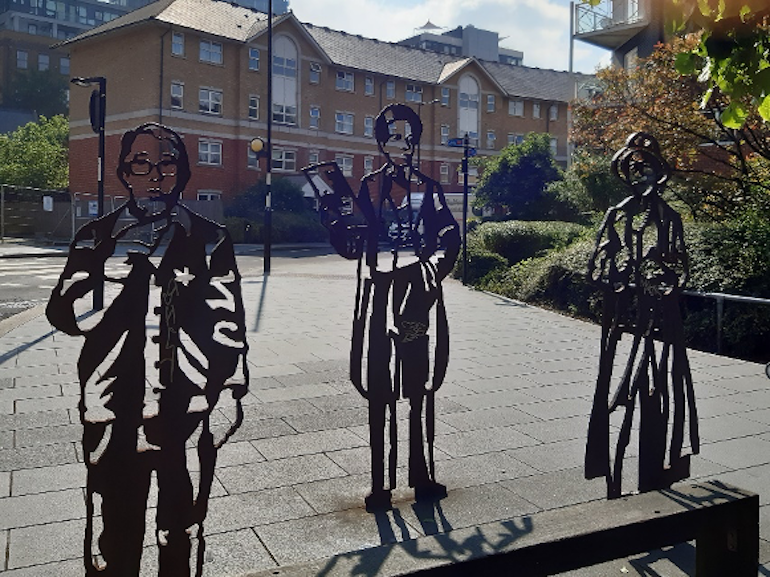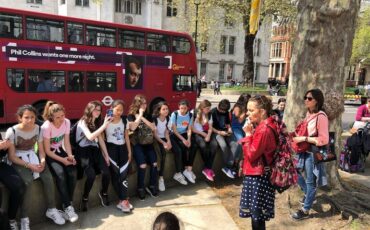I was once asked to do a walking tour of Croydon, my borough in London and also where the composer Samuel Coleridge Taylor lived for most of his life. He was a man of mixed heritage who studied music and composed the Hiawatha Wedding Feast inspired by Hiawatha, written by Henry Wadsworth Longfellow.

Samuel Coleridge Taylor. Photo Credit: © Public Domain via Wikimedia Commons.
Coleridge Taylor was born on 15th August 1875 at 15 Theobald’s Road near to Red Lion Square in central London. His father was African, Dr. Peter Taylor, who left for Sierra Leone in early 1875, never to return. It is believed he was unaware that his girlfriend Alice Martin was pregnant. Two years later Alice, her son Coleridge (as he was known by his family) and their extended family left the area for Croydon in Surrey.
I found several addresses in Croydon where he lived both as a child and as a family man, some close to where I live. (Thank goodness for Google Maps!) I use addresses in Croydon to chart his life as a promising music student and composer who was considered the equal of Elgar but who was also very proud of his heritage and how it influenced his music and life.
Coleridge Taylor’s family first settled into 67 Waddon New Road, now demolished. A map of the local area in 1898 shows that the house was situated downwind of slaughterhouses on the far side of the railway tracks which took steam trains to West Croydon station.
It is fair to say he had a supportive family, but what was life like for young Coleridge as a mixed-race child? He was shy and reserved, either cruelly taunted by local children, who called him ‘Coaley’, or else seen as ‘exotic’ and dressed up as an African child by local painters. He would often be seen playing on his own and singing. A violin teacher Joseph Beckwith saw him playing marbles whilst guarding a small violin and invited the seven-year-old into his home and gave him free music lessons.
This music teacher went on to help him to explore his musical talent and encouraged him to create alternative music for the National Anthem, even though Coleridge was just nine years old. He won a school singing competition singing Cherry Ripe. ‘Music seemed born in him,’ his teacher said and the youngster’s reputation grew as Beckwith taught him.
At the age of fifteen, Coleridge Taylor gained a scholarship to the Royal College of Music to study violin. He would later decide to study composition under the composer Charles Villiers Stanford, who was Professor of Composition at the RCM. Reports from the College reveal that he excelled in his studies and was described as ‘one of my cleverest pupils’ by his piano tutor. His contemporaries at the time were Gustav Mahler, Gustav Holst & Edward Elgar.
As was the fashion for composers, he looked for inspiration from poets from various backgrounds. Coleridge Taylor loved Henry Wadsworth’s poem Hiawatha and committed it to memory. He decided to set the words to music in a choral work called Hiawatha’s Wedding Feast. The piece was well-received and in 1898 the college hosted its first performance. It would be performed again in 1900 at the Royal Albert Hall. Unfortunately, Coleridge Taylor had sold the copyright to publishing firm Novello for a mere fifteen guineas. Though thousands of copies of the Hiawatha score were sold he did not see a penny of the profits thereafter.
 30 Dagnall Park, Samuel Coleridge-Taylor’s House. Photo Credit: © Peter Trimming via Wikimedia Commons.
30 Dagnall Park, Samuel Coleridge-Taylor’s House. Photo Credit: © Peter Trimming via Wikimedia Commons.
There is a Blue Plaque on the house at 30 Dagnall Park SE25 – this address is in the contract Coleridge Taylor signed on 19th October 1898 with Novello and Co Ltd, which was witnessed by his mother Alice Evans. By the time he left college, Coleridge was a published and widely performed composer, but he was not earning enough money to keep him afloat and support his new wife and had to find teaching and conducting work to subsidise his income.
Coleridge Taylor was asked to conduct Hiawatha in the USA in 1901 but could not afford to forgo paying commitments at home. Between 1901 and 1904 he taught at the Croydon Conservatoire, Trinity College of Music, and Crystal Palace School of Art and Composition
Coleridge Taylor was considered the most famous person of African descent living in England in 1900 and this attracted other black people. He was involved in the Pan-African Conference providing musical entertainment, rubbing shoulders with influential people from both Africa & America. He made friends with John Archer, a photographer from Battersea, and Dr. John Alcindor whose practice was in Paddington, both of whom have their own stories in black British history.
 Blue Plaque for Samuel Coleridge-Taylor, Dagnell Park, Selhurst. Photo Credit: © Peter Trimming via Wikimedia Commons.
Blue Plaque for Samuel Coleridge-Taylor, Dagnell Park, Selhurst. Photo Credit: © Peter Trimming via Wikimedia Commons.
During his musical studies and career, he met and collaborated with many writers and musicians, some of whom were invited to his Dagnall Park home. These include the African-American poet and novelist Paul Laurence Dunbar, writer of Dream Lovers. His fame and interaction with African and African-American elites gave him a voice. Writing in the Croydon Guardian he challenged what he saw as ‘appalling amount of ignorance amongst English people regarding the negro and his doings’. Unbeknown to him, this ignorance (or racism) was also expressed by those who had originally encouraged him as a student, men such as Edward Elgar and August Jaegar.
Hill Crest, a large Victorian house on the corner of Ederline Avenue and the London Road was where Coleridge Taylor set music to the poetry of Alfred Noyes, such as A Tale of Old Japan. In 1910 the family moved from Hill Crest to a smaller home at 6, St Leonards Road in Aldwick, Croydon. He is reputed to have said that the horse and cart traffic along the London Road was too noisy!
In the absence of royalties from Hiawatha, Taylor worked tirelessly, composing incidental music for four plays at Her Majesty’s Theatre in central London. He was an adjudicator at music festivals, a teacher and a conductor wrote sacred and secular choral works and piano pieces. The Musical Times published a ten-page article about him. There was no time to stop: fame was good but money was necessary.
 Photographs and text about Samuel Coleridge Taylor at Wetherspoons Pub. Photo Credit: © J D Wetherspoon plc.
Photographs and text about Samuel Coleridge Taylor at Wetherspoons Pub. Photo Credit: © J D Wetherspoon plc.
West Croydon Station is the place where Samuel Coleridge-Taylor collapsed on 1st September 1912. He died of pneumonia, complicated by exhaustion from overwork. He was just thirty-seven. The news of his death was spread by news agencies and reached many parts of the world in days. His funeral drew many from the African community to Croydon. Cards from the wreaths and the newspaper reports are held by the Royal College of Music.
The circumstances of the death of Samuel Coleridge Taylor prompted the adoption of a new system of royalties for composers in the UK and his widow was awarded a Civil List pension of £100. The poet Alfred Noyes wrote his epitaph: Too young to die: his great simplicity, his happy courage in an alien world, his gentleness, made all that knew him love him.
 Life-size metal sculpture of Samuel Coleridge Taylor on Charles Street in Croydon, London. Photo Credit: © Angela Morgan.
Life-size metal sculpture of Samuel Coleridge Taylor on Charles Street in Croydon, London. Photo Credit: © Angela Morgan.
 Metal statues (left to right): Ronnie Corbet, Samuel Coleridge Taylor, and Dame Peggy Ashcroft. Photo Credit: © Angela Morgan.
Metal statues (left to right): Ronnie Corbet, Samuel Coleridge Taylor, and Dame Peggy Ashcroft. Photo Credit: © Angela Morgan.







Leave a Reply